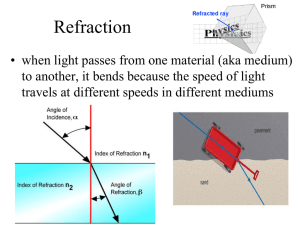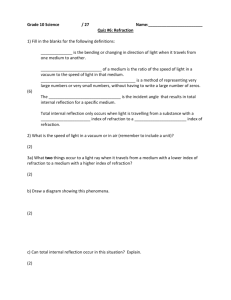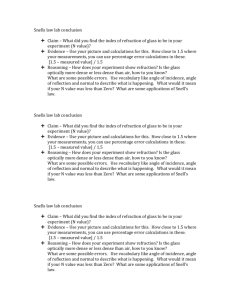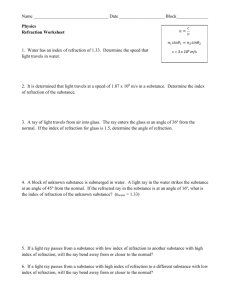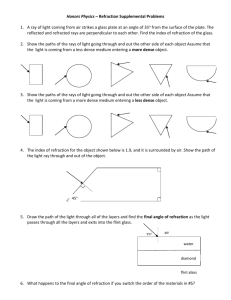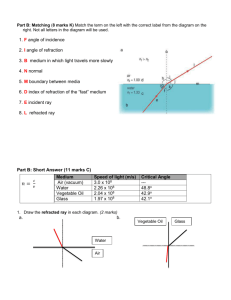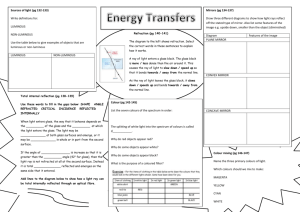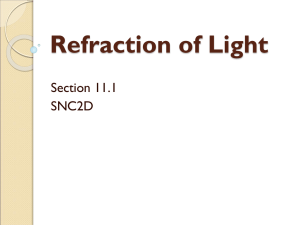Refraction
advertisement
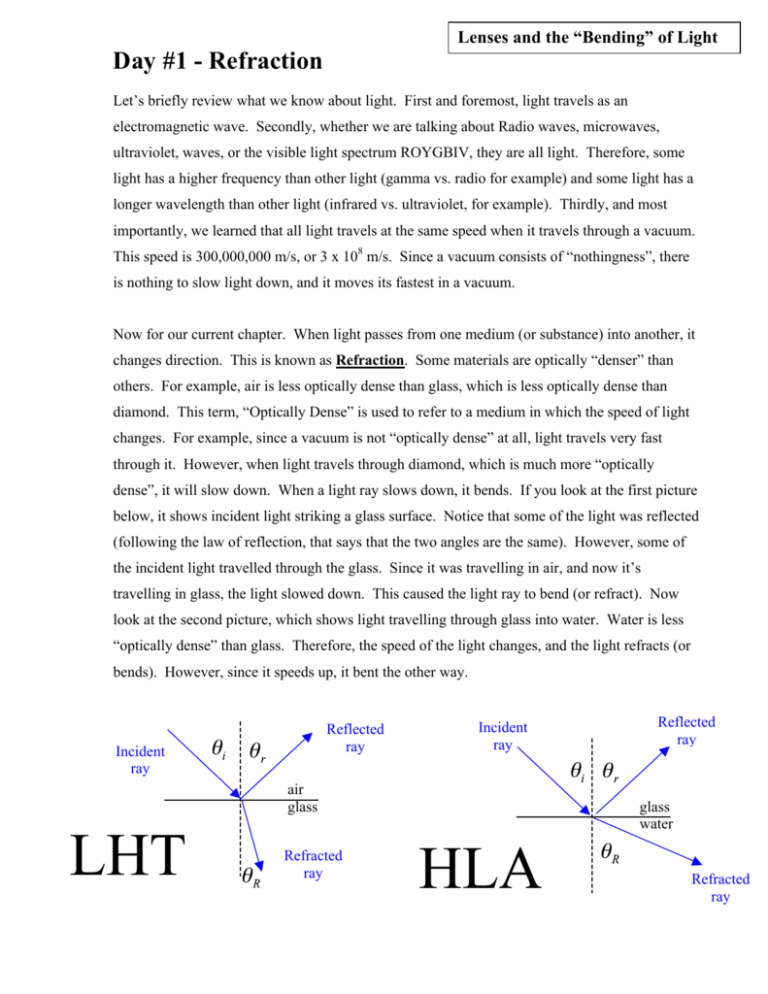
Lenses and the “Bending” of Light Day #1 - Refraction Let’s briefly review what we know about light. First and foremost, light travels as an electromagnetic wave. Secondly, whether we are talking about Radio waves, microwaves, ultraviolet, waves, or the visible light spectrum ROYGBIV, they are all light. Therefore, some light has a higher frequency than other light (gamma vs. radio for example) and some light has a longer wavelength than other light (infrared vs. ultraviolet, for example). Thirdly, and most importantly, we learned that all light travels at the same speed when it travels through a vacuum. This speed is 300,000,000 m/s, or 3 x 108 m/s. Since a vacuum consists of “nothingness”, there is nothing to slow light down, and it moves its fastest in a vacuum. Now for our current chapter. When light passes from one medium (or substance) into another, it changes direction. This is known as Refraction. Some materials are optically “denser” than others. For example, air is less optically dense than glass, which is less optically dense than diamond. This term, “Optically Dense” is used to refer to a medium in which the speed of light changes. For example, since a vacuum is not “optically dense” at all, light travels very fast through it. However, when light travels through diamond, which is much more “optically dense”, it will slow down. When a light ray slows down, it bends. If you look at the first picture below, it shows incident light striking a glass surface. Notice that some of the light was reflected (following the law of reflection, that says that the two angles are the same). However, some of the incident light travelled through the glass. Since it was travelling in air, and now it’s travelling in glass, the light slowed down. This caused the light ray to bend (or refract). Now look at the second picture, which shows light travelling through glass into water. Water is less “optically dense” than glass. Therefore, the speed of the light changes, and the light refracts (or bends). However, since it speeds up, it bent the other way. Reflected ray Incident ray Incident ray air glass LHT Refracted ray Reflected ray glass water HLA Refracted ray What does “LHT” mean? Its an easy way to remember which way the light bends when it enters a new medium (or substance). If the light travels FROM a lite (intentionally speeled wrong to avoid confusing it with the word “light”) medium INTO a heavy medium (in other words, from less dense to more dense), then the light bends TOWARDS the normal. Hence Lite into Heavy bends Towards the normal (LHT) On the other hand, if light travels FROM a heavy (or dense) medium INTO a lite (or less dense) medium, then light bends AWAY from the normal. Hence Heavy into Lite bends Away from the normal (HLA) So…..the question should be, “What makes something more or less optically dense than something else”. We measure a medium’s optical density using a ratio known as the INDEX of REFRACTION, or “n”. It is the ratio of the speed of light in a vacuum (again, 3 x 108 m/s) to the speed of light in a given material. Thus, the index of refraction is given by (where c is the speed of light in a vacuum and v is the speed of light in the new material) If you look at the table at the right, you will see the index of refraction for some common substances. The larger the index, the more light is slowed down, and thus the more it is bent. This can be seen on the following pictures… vacuum air vacuum water vacuum quartz Just a reminder, since all of the pictures above show that Medium Index of Refraction vacuum 1.00 air 1.003 water 1.33 ethanol 1.36 fluorite 1.43 polystyrene 1.49 crown glass 1.52 quartz 1.54 Zircon 1.92 diamond 2.42 light travels from a vacuum (less dense, Lite) into something else (more dense, or Heavy), the light bends Towards the normal. Hence LHT. On the other hand, the refracted light would have bent AWY FROM the normal if the incident light travelled from heavy into lite (hence, HLA). OK, so hopefully we see that light bends when it travels from one substance (or medium) into another substance. But “HOW MUCH WILL IT BEND???” We know two things. #1) The refracted ray bends more if the indices refraction of the two different materials are far apart. Hence, light travelling from fluorite into quartz only bends a little (since the indices are 1.43 and 1.54), while light travelling from ethanol into zircon bends a lot (since 1.36 and 1.92 have a larger gap between them). #2) The actual “angle of refraction”, the angle between the normal and the refracted ray, can be found using a law called “Snell’s Law”. Snell’s Law: Incident ray Reflected ray Incident medium (n1) Refracted medium (n2) Refracted ray So, let’s review. Light bends. When it travels through a vacuum, it travels at the speed of light, 3 x 108 m/s. Since the index of refraction of air is VERY close to that of a vacuum, light travels at approximately 3E8 m/s through air. When is enters a medium that is more optically dense (water or glass, for example) it will SLOW DOWN and bend towards the normal. This would mean that the angle of refraction would be LESS than the angle of incidence. If light travels from one medium into a less dense medium (whose index is smaller), then it SPEEDS UP and it BENDS AWAY from the normal (thus making the angle of refraction greater than the angle of incidence). Refraction Worksheet 1. Using the table on the previous page, find the speed of light in fluorite. 2. What would the index of refraction be if the speed of light through a certain material were 1.73 x 108 m/s? 3. What is the minimum value of the index of refraction? Explain your reasoning as to why this must be true. 4. Light travels from quartz into water. Will the light bend towards the normal or away from it? Fully explain why? 5. Light travels from air into crown glass. If the incident angle is 50o, use Snell’s Law to find the angle of refraction. 6. A ray of incident light (with an angle of incidence of 60o) leaves Zircon and enters an unknown medium. It bends away from the normal with an angle of refraction of 80o. Use Snell’s Law to find the index of refraction of this new material. 7. Red light, of wavelength 700nm (nanometers), is travelling through the air when it encounters a diamond surface. If the frequency of the light never changes, find the wavelength of the light as it passed through the diamond, using both the wave equation and the equation for the index of refraction. ( ) The minimum value is 1. Since v = c/n, if n was less than 1, then the velocity of light in that material would be faster than the speed of light in a vacuum. Since a vacuum offers no resistance to light, 3E8 MUST be the theoretical maximum for light’s speed, and therefore, “n” CANNOT be less than 1. Quart is high-index (optically heavy). Water is low index (optically light). Therefore…HLA! The refracted light will bend AWAY from the normal.
